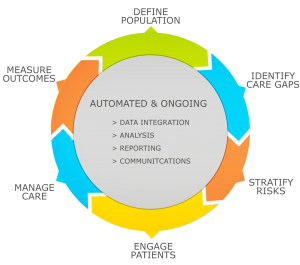Home / Blog / 5 Ways Telemedicine Can Help Your Population Health Management Plan
 A population health management plan is put in place to improve the quality of healthcare for patients while reducing associated costs within a healthcare organization. By implementing a number of technology resources, patient data is aggregated to provide one single picture of a patient and their current health status.
A population health management plan is put in place to improve the quality of healthcare for patients while reducing associated costs within a healthcare organization. By implementing a number of technology resources, patient data is aggregated to provide one single picture of a patient and their current health status.
According to a study by HIMSS Analytics, 67% of healthcare organizations already have a population health management plan in place.
While telemedicine is just one piece of technology, take a look below at the 5 ways providing it as an additional way to access care can help improve your health system’s PHM program.
Telemedicine Reduces Gaps in Care
By allowing patients to see a doctor within a network without having to rely on scheduled, routine visits, it allows a patient to seek care when it matters most. Patients no longer need to wait for appointments and can seek care for ailments much quicker. This allows certain illnesses and diseases to be caught earlier and treated faster in a less expensive manner. The sooner a sickness is detected, the less work there is involved in developing a cure plan.
Telemedicine Reduces High-Cost Facility Visits
By giving your population a way to access healthcare that is available 24/7 and easily accessible from any location you’re able to decrease high-cost visits to facilities such as emergency departments and urgent care offices. 71% of emergency department visits are not deemed as an emergency. 1 Non-emergency visits usually took place because there was not another option in care available for the time the medical condition occurred. A telemedicine visit costs patients, on average, $50 compared to the over $2,000 emergency department visit or the nearly $200 urgent care visit.
Telemedicine Improves Care Coordination
Depending on the telemedicine platform of your choosing, care coordination can be improved with a telemedicine provider who is willing to work with all locations and physicians within your healthcare provider network. Rather than having a disparate system that doesn’t share visit results or treatment plans, telemedicine can help bridge the gap by coordinating one patient’s needs with all specialists in a single network.
Telemedicine Helps with Patient Flow
The care that is available 24/7 and that can be given to a patient who is at home in their living room opens up time slots never thought possible for a doctor visit. Health systems are able to see more patients than ever before. In addition to having more time, by choosing a telemedicine provider who comes with a team of already trained and experienced virtual health physicians, it alleviates the stress of physician shortages.
Reach Broader Markets
Health systems near rural areas or those who treat the underserved may have a harder time establishing a connection with patients. By utilizing mobile connectivity, health systems are able to reach people who might otherwise not have the resources for traveling to and from healthcare appointments. Members of these communities are known to have higher incidences of disease and disability and have higher rates of pain and suffering but have proven to be adopters of mobile technology.
—
As health systems strive towards having a better population health management plan in place, there are many technologies they will consider adopting. In order to continue to reach their patients, they will want to focus on alternatives to the traditional in-office visit. Patients, especially those who must be seen often, will be looking for ease of use and convenience. Health systems should consider adopting telemedicine as an additional channel to provide care to their population.
1 http://www.beckershospitalreview.com/patient-flow/study-71-of-ed-visits-unnecessary-avoidable.html
Ready to learn how RelyMD can help your population health management plan?
Submit the form below and we’ll be in touch soon.
[pardot-form width=”400″ height=”300″ id=”807″ title=”Web Form – Blog – Learn More”]
